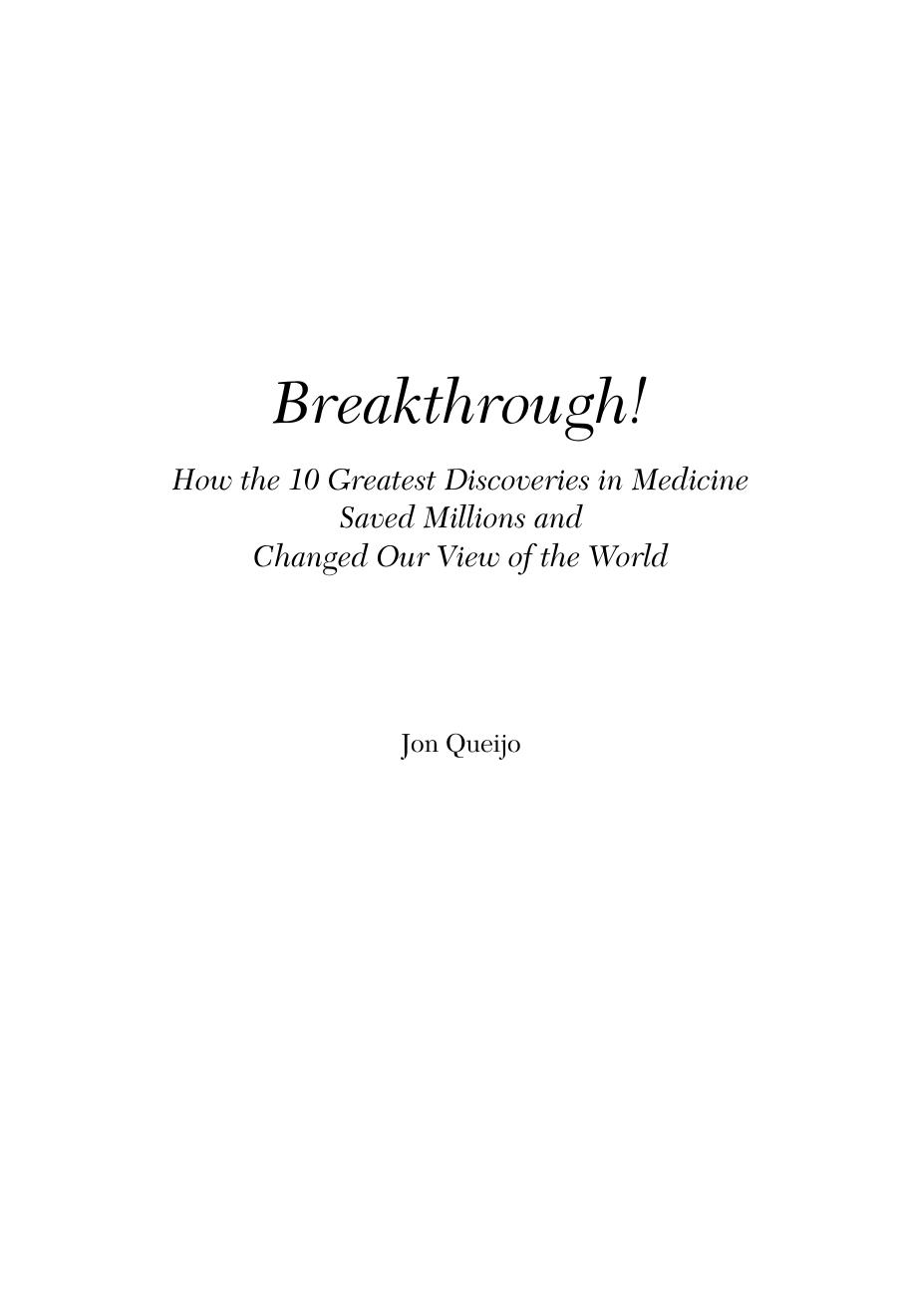Breakthrough!: How the 10 Greatest Discoveries in Medicine Saved Millions and Changed Our View of the World by Jon Queijo

Author:Jon Queijo [Queijo, Jon]
Language: eng
Format: mobi, epub, pdf
Tags: Genetics, Medical, Research, Medicine, Discoveries in science, History, Science
ISBN: 9780137137480
Publisher: Pearson Education, Limited
Published: 2010-03-30T17:24:34+00:00
Milestone #1 “That’s funny”: the strange and serendipitous discovery of penicillin
Although most of us prefer to not think about it, just as we are surrounded by countless bacteria, we are similarly exposed to numerous invisible mold spores that waft in daily through our windows and doors, seeking moist surfaces on which to land and germinate. This was pretty much what Alexander Fleming was thinking when, in the summer of 1928, he returned from a long holiday and noticed something growing on a glass culture plate he had left in a corner of his laboratory bench. Fleming was a physician and bacteriologist in the Inoculation Department at St. Mary’s Hospital in London, and he had previously inoculated the culture plate with staphylococcus bacteria as part of a research project. Returning from vacation, Fleming had randomly grabbed the glass plate, removed its lid, and was about to casually show it to a colleague, when he peered inside and said, “That’s funny...”
Fleming wasn’t surprised to see that the surface of the plate was speckled by dozens of colonies of staphylococcus bacteria—that was part of his experiment. Nor was he surprised that one side of the plate was covered by a large splotch of mold. After all, he had been away for two weeks and was planning to discard the culture plate anyway. What caught his eye was something he didn’t see. Although bacterial colonies covered most of the plate, there was one spot where they came to screeching halt, forming a translucent ring around something they clearly did not like: the giant patch of mold. What’s more, the bacteria closest to the mold were clearly disintegrating, as if the mold were releasing something so potent that it was killing them by the millions.
Fortunately, Fleming—who only a few years earlier had discovered lysozyme, a natural bacteria-fighting substance made by a number of tissues in the body—recognized an important discovery when he saw it. As he later wrote, “This was an extraordinary and unexpected appearance, and seemed to demand investigation.” Over the next few months, Fleming did exactly that, growing cultures of the mold and studying how the mysterious yellow substance it released affected other types of bacteria. He soon realized that the mold was a specific type of Penicillium, and that the substance it released was able to inhibit or kill not just staphylococcus, but many other types of bacteria. A few months later, in 1929, he named the substance “penicillin” and published his first paper about its remarkable properties.
What made penicillin so special? First of all, unlike the lysozyme he had discovered a few years earlier, penicillin stopped or killed many types of bacteria known to cause important human diseases, including staphylococcus, streptococcus, pneumococcus, meningococcus, gonococcus, and diphtheria. What’s more, penicillin was incredibly potent. Even in its relatively crude form, it could be diluted to 1 part in 800 before losing its ability to stop staphylococcus bacteria. At the same time, penicillin was remarkably nontoxic to the body’s cells, including infection-fighting white blood cells.
Download
Breakthrough!: How the 10 Greatest Discoveries in Medicine Saved Millions and Changed Our View of the World by Jon Queijo.epub
Breakthrough!: How the 10 Greatest Discoveries in Medicine Saved Millions and Changed Our View of the World by Jon Queijo.pdf
This site does not store any files on its server. We only index and link to content provided by other sites. Please contact the content providers to delete copyright contents if any and email us, we'll remove relevant links or contents immediately.
| Administration & Medicine Economics | Allied Health Professions |
| Basic Sciences | Dentistry |
| History | Medical Informatics |
| Medicine | Nursing |
| Pharmacology | Psychology |
| Research | Veterinary Medicine |
The Immortal Life of Henrietta Lacks by Rebecca Skloot(4550)
An American Plague by Jim Murphy(3735)
The Emperor of All Maladies: A Biography of Cancer by Siddhartha Mukherjee(3112)
The Gene: An Intimate History by Siddhartha Mukherjee(3074)
The Fate of Rome: Climate, Disease, and the End of an Empire (The Princeton History of the Ancient World) by Kyle Harper(3032)
Rebecca Skloot by The Immortal Life of Henrietta Lacks(1988)
Stiff - The Curious Lives of Human Cadavers by Mary Roach(1836)
The Great Influenza by John M Barry(1763)
The Vaccine Race by Meredith Wadman(1639)
Hero by Michael Grant(1621)
Undue Risk by Moreno Jonathan D.;(1610)
Three Cups of Tea by Greg Mortenson(1598)
The Mystery of the Exploding Teeth by Thomas Morris(1557)
Quackery by Lydia Kang(1534)
Autism's False Prophets by Paul A. Offit(1516)
A Journal of the Plague Year (Oxford World's Classics) by Daniel Defoe(1503)
Extremes: Life, Death and the Limits of the Human Body by Fong Kevin(1502)
Steroids: History, Science, and Issues by Standora Joan E.; Bogomolnik Alex; Slugocki Malgorzata(1499)
The Vaccine Court by Rohde Wayne(1488)
